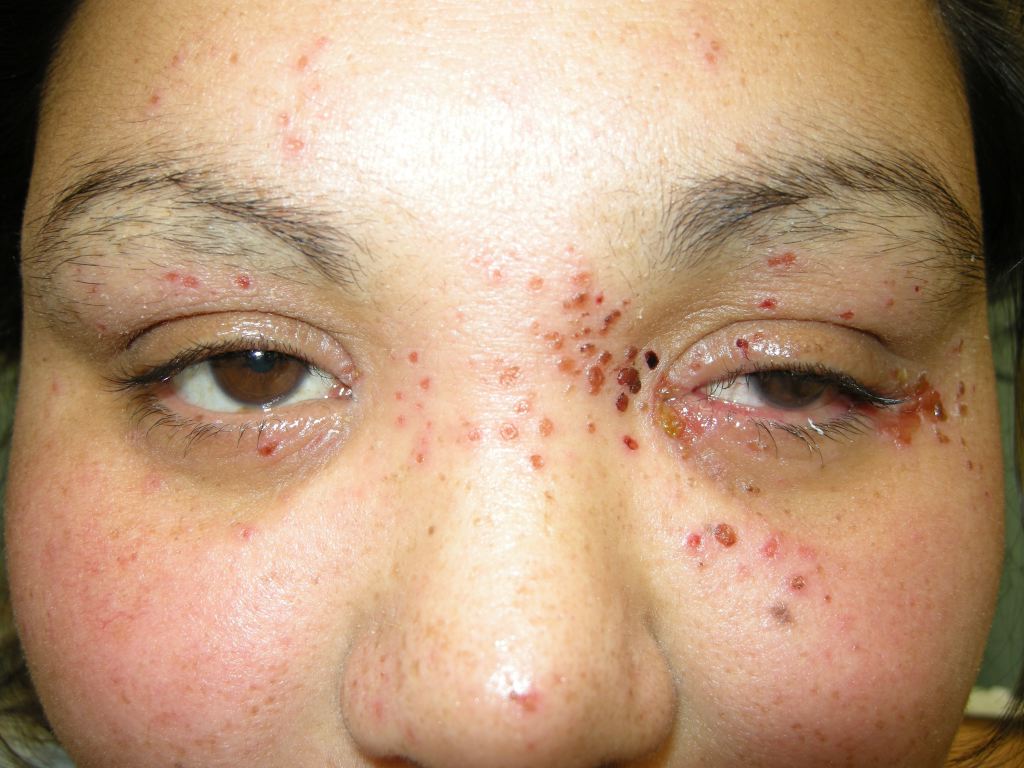[1]
Micali G, Lacarrubba F. Eczema Herpeticum. The New England journal of medicine. 2017 Aug 17:377(7):e9. doi: 10.1056/NEJMicm1701668. Epub
[PubMed PMID: 28813215]
[2]
Seegräber M, Worm M, Werfel T, Svensson A, Novak N, Simon D, Darsow U, Augustin M, Wollenberg A. Recurrent eczema herpeticum - a retrospective European multicenter study evaluating the clinical characteristics of eczema herpeticum cases in atopic dermatitis patients. Journal of the European Academy of Dermatology and Venereology : JEADV. 2020 May:34(5):1074-1079. doi: 10.1111/jdv.16090. Epub 2020 Jan 30
[PubMed PMID: 31733162]
Level 2 (mid-level) evidence
[3]
Vera-Kellet C, Hasbún C. Eczema herpeticum: A medical emergency in patients with atopic dermatitis. IDCases. 2020:19():e00663. doi: 10.1016/j.idcr.2019.e00663. Epub 2019 Nov 6
[PubMed PMID: 32226756]
Level 3 (low-level) evidence
[4]
Wollenberg A, Wetzel S, Burgdorf WH, Haas J. Viral infections in atopic dermatitis: pathogenic aspects and clinical management. The Journal of allergy and clinical immunology. 2003 Oct:112(4):667-74
[PubMed PMID: 14564342]
[5]
Leung DY. Why is eczema herpeticum unexpectedly rare? Antiviral research. 2013 May:98(2):153-7. doi: 10.1016/j.antiviral.2013.02.010. Epub 2013 Feb 22
[PubMed PMID: 23439082]
[6]
Lehman JS, el-Azhary RA. Kaposi varicelliform eruption in patients with autoimmune bullous dermatoses. International journal of dermatology. 2016 Mar:55(3):e136-40. doi: 10.1111/ijd.13091. Epub 2015 Oct 24
[PubMed PMID: 26500144]
[7]
Walker K, Martini A, Philips H, Sharp L, Thomas K, Tarbox M. Darier disease with disseminated herpes simplex virus type 2 infection. Dermatology online journal. 2019 Apr 15:25(4):. pii: 13030/qt4qg8s971. Epub 2019 Apr 15
[PubMed PMID: 31046908]
[8]
Hata TR, Kotol P, Boguniewicz M, Taylor P, Paik A, Jackson M, Nguyen M, Kabigting F, Miller J, Gerber M, Zaccaro D, Armstrong B, Dorschner R, Leung DY, Gallo RL. History of eczema herpeticum is associated with the inability to induce human β-defensin (HBD)-2, HBD-3 and cathelicidin in the skin of patients with atopic dermatitis. The British journal of dermatology. 2010 Sep:163(3):659-61. doi: 10.1111/j.1365-2133.2010.09892.x. Epub 2010 Jun 9
[PubMed PMID: 20545685]
[9]
Mathias RA, Weinberg A, Boguniewicz M, Zaccaro DJ, Armstrong B, Schneider LC, Hata TR, Hanifin JM, Beck LA, Barnes KC, Leung DY. Atopic dermatitis complicated by eczema herpeticum is associated with HLA B7 and reduced interferon-γ-producing CD8+ T cells. The British journal of dermatology. 2013 Sep:169(3):700-3. doi: 10.1111/bjd.12382. Epub
[PubMed PMID: 23600999]
[10]
Damour A, Garcia M, Seneschal J, Lévêque N, Bodet C. Eczema Herpeticum: Clinical and Pathophysiological Aspects. Clinical reviews in allergy & immunology. 2020 Aug:59(1):1-18. doi: 10.1007/s12016-019-08768-3. Epub
[PubMed PMID: 31836943]
[11]
Lyons JJ, Milner JD, Stone KD. Atopic dermatitis in children: clinical features, pathophysiology, and treatment. Immunology and allergy clinics of North America. 2015 Feb:35(1):161-83. doi: 10.1016/j.iac.2014.09.008. Epub 2014 Nov 21
[PubMed PMID: 25459583]
[12]
Silverberg JI, Hanifin JM. Adult eczema prevalence and associations with asthma and other health and demographic factors: a US population-based study. The Journal of allergy and clinical immunology. 2013 Nov:132(5):1132-8. doi: 10.1016/j.jaci.2013.08.031. Epub 2013 Oct 4
[PubMed PMID: 24094544]
[13]
Hsu DY, Shinkai K, Silverberg JI. Epidemiology of Eczema Herpeticum in Hospitalized U.S. Children: Analysis of a Nationwide Cohort. The Journal of investigative dermatology. 2018 Feb:138(2):265-272. doi: 10.1016/j.jid.2017.08.039. Epub 2017 Sep 18
[PubMed PMID: 28927889]
[14]
Wollenberg A, Zoch C, Wetzel S, Plewig G, Przybilla B. Predisposing factors and clinical features of eczema herpeticum: a retrospective analysis of 100 cases. Journal of the American Academy of Dermatology. 2003 Aug:49(2):198-205
[PubMed PMID: 12894065]
Level 2 (mid-level) evidence
[15]
Zhuang K, Wu Q, Ran X, Ran Y, Ding L, Xu X, Lei S, Lama J. Oral treatment with valacyclovir for HSV-2-associated eczema herpeticum in a 9-month-old infant: A case report. Medicine. 2016 Jul:95(29):e4284. doi: 10.1097/MD.0000000000004284. Epub
[PubMed PMID: 27442669]
Level 3 (low-level) evidence
[16]
Luca NJ, Lara-Corrales I, Pope E. Eczema herpeticum in children: clinical features and factors predictive of hospitalization. The Journal of pediatrics. 2012 Oct:161(4):671-5. doi: 10.1016/j.jpeds.2012.03.057. Epub 2012 May 9
[PubMed PMID: 22575249]
[17]
Atherton DJ, Harper JI. Management of eczema herpeticum. Journal of the American Academy of Dermatology. 1988 Apr:18(4 Pt 1):757-8
[PubMed PMID: 3372774]
[18]
Sohail M, Khan FA, Shami HB, Bashir MM. Management of eczema herpeticum in a Burn Unit. JPMA. The Journal of the Pakistan Medical Association. 2016 Nov:66(11):1357-1361
[PubMed PMID: 27812048]
[19]
Wollenberg A. Eczema herpeticum. Chemical immunology and allergy. 2012:96():89-95. doi: 10.1159/000331892. Epub 2012 Mar 13
[PubMed PMID: 22433376]
[20]
Wheeler CE Jr, Abele DC. Eczema herpeticum, primary and recurrent. Archives of dermatology. 1966 Feb:93(2):162-73
[PubMed PMID: 4159394]
[21]
Aronson PL, Yan AC, Mittal MK, Mohamad Z, Shah SS. Delayed acyclovir and outcomes of children hospitalized with eczema herpeticum. Pediatrics. 2011 Dec:128(6):1161-7. doi: 10.1542/peds.2011-0948. Epub 2011 Nov 14
[PubMed PMID: 22084327]
[22]
Beck LA, Boguniewicz M, Hata T, Schneider LC, Hanifin J, Gallo R, Paller AS, Lieff S, Reese J, Zaccaro D, Milgrom H, Barnes KC, Leung DY. Phenotype of atopic dermatitis subjects with a history of eczema herpeticum. The Journal of allergy and clinical immunology. 2009 Aug:124(2):260-9, 269.e1-7. doi: 10.1016/j.jaci.2009.05.020. Epub 2009 Jun 27
[PubMed PMID: 19541356]
[23]
Narla S,Silverberg JI, Association between atopic dermatitis and serious cutaneous, multiorgan and systemic infections in US adults. Annals of allergy, asthma
[PubMed PMID: 29273131]

